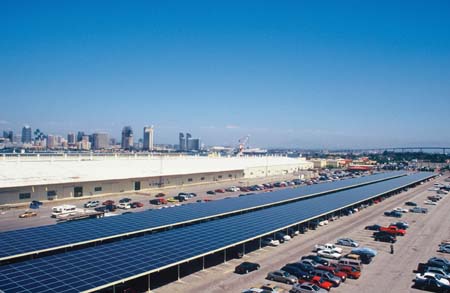
There are many revolutionary things being done on behalf of controlling climate change, began Arjun Makhijani in describing his "Roadmap for a Zero-CO2 Emissions Economy in the United States" to the American Association of Physics Teachers in Greensboro (NC) on 1 August 2007, but there are no lobbyists for them. At the same time, he lamented, lobbyists argue to preserve the status quo.
That status quo, he went on, is characterized by emission of greenhouse gases, 84% of which are fossil-fuel related, China and India will not accept a reduction in their greenhouse gas emissions, he noted, and fulfilling Europe's goal of controlling catastrophic climate change requires more than 90% reduction of greenhouse gases from the United States (essentially a zero carbon dioxide economy). The status quo is also based on oil. But the problem with oil, the president of the Institute for Energy and Environmental Research (IEER) in Takoma Park, MD, noted, is not when world peak production will occur, but rather one of international conflict. (Makhijani added that Daniel Yergin's The Prize is a good place to start to understand the history and politics of oil.)
Lastly, the status quo is characterized by incipient nuclear proliferation using nuclear power as the entry point. Under the terms of the nonproliferation treaty (NPT), no country will give up its commercial reprocessing rights, since the treaty guarantees access to all commercial nuclear technology.
Running a zero carbon dioxide economy, and doing it without nuclear energy, will not be a "slam dunk," Makhijani said, but it can be done. "Business as usual" since 1973, he noted, has reduced the ratio of energy growth to GDP growth to 1/3 (down from 1 before 1973). Makhijani went on to say that US energy efficiency is still in the Neanderthal Age -- but he noted that this gives huge room for improvement, both in buildings and transportation. In fact, Makhijani said that half the key to his recipe for a carbon-free and nuclear-free economy is efficiency. With existing technology, GDP can grow at three percent per year, while delivered energy use declines by one percent per year for the next four decades.
Other elements of that recipe include transportation fueled by batteries, hydrogen (in internal combustion engines rather than fuel cells, for reasons based on cost and infrastructure), and biofuels made from algae bioreactors (which capture up to 5% of incoming solar energy), high productivity aquatic plants like water hyacinths (which also clean waste water), and prairie grasses For electricity he would make greater use of solar photovoltaics (they can be used to cover parking lots – see photo at end) and wind (five midwestern states have more wind potential than all US power plants).
Makhijani acknowledged that half an hour gave him time only to barely touch on the elements of his carbon-free, nuclear-free plan. For fuller details he referred his listeners to his forthcoming book, Carbon-Free and Nuclear-Free: A Roadmap for U.S. Energy Policy. Both the executive summary and the book itself are available from the IEER website.
There readers will see Makhijani begin with the same three fronts of the global energy crisis with which he began his talk -- climate disruption, insecurity of oil supply, and nuclear proliferation. "A zero-CO2 U.S. economy without nuclear power is not only achievable -- it is necessary for environmental protection and security," he writes. Later in the same paragraph he adds that he would like to "establish the United States as a country that leads by example rather than one that preaches temperance from a barstool."
In a box on page four are "The Clean Dozen" -- recommendations that need to be followed for the success of his plan, including the elimination of subsidies and tax breaks for fossil fuels, nuclear power, and biofuels from food crops (they are needed more for food) and the enactment of stringent efficiency standards for buildings and vehicles.
The bulk of the remainder are eight "findings," the first two of which refer the need for a zero-CO2 economy and means of achieving it. The third finding describes how electrical needs can be met both without carbon dioxide and nuclear energy. Although solar and wind are intermittent energy sources, Makhijani proposes interfacing photovoltaics with batteries of idle cars (since vehicular batteries can be "deep discharged far more times than needed simply to operate the vehicle over its lifetime") and wind with compressed air storage and hydropower/pumped storage. He would produce baseload power by geothermal and biomass-fueled generating stations (with the provisos on biomass fuels as noted above).
Makhijani's fourth finding enumerates the risks that accompany nuclear energy -- proliferation, terror, accidents, and wastes. The fifth emphasizes the importance of highly efficient energy technologies. The sixth put the role of biomass in perspective, by explaining why Makhijani is opposed to not only ethanol from corn but also biodiesel from palm oil, yet at the same time extolling the production of hydrogen by the interaction of solar energy with algae. The seventh finding states the economic cost of Makhijani's plan, and the eighth points up how industries displaced by the plan can be replaced by industries needed to achieve the plan. At the end are six pages of tables listing technologies needed to implement the plan, their present status, the year they are expected to be deployable for large-scale use, important next steps, and the carbon dioxide abatement cost and other obstacles.

Parking lot in San Diego covered by photovoltaic cells. Courtesy of PowerLight Corporation.